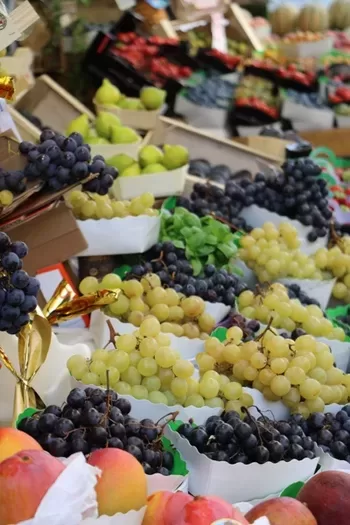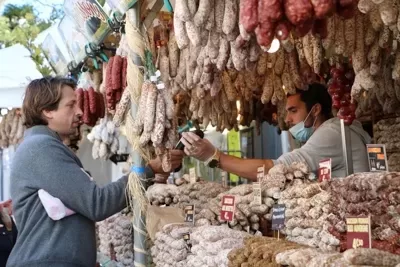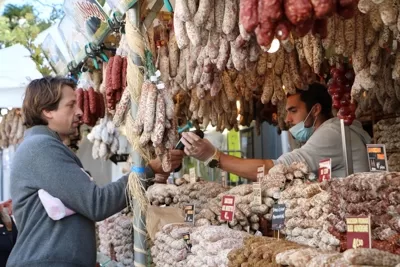The choice between buying fruit and vegetables from farmers’ markets or supermarkets depends on individual preferences, priorities, and values. While farmers’ markets offer freshness, community support, and environmental benefits, supermarkets provide convenience, affordability, and a wider selection of products.
Buying fruit and vegetables from farmers’ markets versus supermarkets presents distinct advantages and considerations, shaping consumers’ choices based on various factors:
Freshness and Quality:


If flavor quality holds significant importance for you, then the farmers’ market is your ideal destination. You’ll find more likelihood of purchasing heritage and older varieties prized for their aroma, taste, and flavor.
However, these fruits and vegetables are bred for taste rather than durability, and they may not transport or store as effectively as their counterparts found in supermarkets. If longevity outweighs flavor and aroma in your preferences, then shopping at a supermarket would be more suitable.
Farmers’ Markets: Produce at farmers’ markets is often fresher and of higher quality since it’s typically harvested locally and sold directly by the growers. These markets offer a wider variety of seasonal and heirloom produce, often picked at peak ripeness for optimal taste and nutrition.
Supermarkets: While supermarkets offer convenience and a wide selection of produce year-round, the quality and freshness may vary. Produce in supermarkets may have been transported long distances and stored for extended periods, affecting flavor and nutritional value.
Supporting Local Farmers:
The profits generated by supermarkets benefit their shareholders, whereas the profits from farmers’ markets directly support the farmers themselves. Shopping local keeps your dollars locally for longer.
Farmers’ Markets: Purchasing from farmers’ markets directly supports local farmers and their communities. It allows consumers to forge connections with growers, learn about farming practices, and contribute to the sustainability of small-scale agriculture.
There are currently 190 farmers’ markets listed on the Australian Farmer’s Market Association website. Find a Farmer’s Market near you here. These markets vary in size and schedules ranging from half-day openings once a month to weekly operations.
Supermarkets: Supermarket chains source their produce from various suppliers, often on a larger scale and sometimes from global markets. While they may also carry local produce, the emphasis is not always on supporting local farmers.
There are 1,114 Woolworths supermarkets in Australia, 850 Coles, 570 Aldi and 1400 IGA Supermarkets in Australia as of March, 2024. Nearly all of these supermarkets are open seven days a week.
Price and Affordability:
Although you may stumble upon remarkably inexpensive loss leaders in supermarkets, when comparing quality seasonal produce head-to-head, the price disparity between the two is minimal, with supermarkets often edging slightly cheaper. This comparison dispels the misconception that farmers’ markets are significantly more expensive.


Loss leaders in supermarkets, typically prominently displayed and heavily promoted, refer to products that are sold at a loss or very low price in order to attract customers into the store with the expectation that they will also purchase other items with higher profit margins while they are there.
Farmers’ Markets: Prices at farmers’ markets may vary depending on factors such as location, seasonality, and organic certification. While some items may be priced higher due to their quality and freshness, others may be more affordable compared to supermarket equivalents.
Supermarkets: Supermarkets often offer competitive pricing due to their ability to purchase in bulk and negotiate prices with suppliers. They may also run promotions and discounts on certain items, making them appealing for shoppers on a budget.
Environmental Impact:
Farmers’ Markets: Shopping at farmers’ markets reduces the carbon footprint associated with long-distance transportation and packaging. Locally grown produce typically requires less energy for transportation and refrigeration, contributing to lower emissions and environmental sustainability.
Supermarkets: Supermarkets rely on extensive distribution networks to supply produce from various regions and countries, leading to higher greenhouse gas emissions from transportation. Additionally, supermarkets often use plastic packaging, contributing to waste and environmental pollution.
Convenience and Accessibility:
Farmers’ Markets: Farmers’ markets may have limited operating hours and locations, making them less convenient for some consumers. However, they offer a unique shopping experience and the opportunity to engage with local farmers and artisans.
Supermarkets: Supermarkets are widely accessible and offer extended operating hours, making them convenient for busy consumers. They provide a one-stop-shop for groceries, household items, and other necessities, with the added convenience of online ordering and delivery options in many cases.
What to look for at local markets
According to consumer law, retailers are required to furnish a receipt within seven days of a purchase if the sale amount is under $75. However, many stall holders at farmers’ markets fail to comply with this regulation.
The National Measurement Act stipulates the use of approved scales for goods sold by weight. Household scales to weigh food for sale, do not meet this standard. There have been some reports from farmers markets of produce transferred from a box into a paper bag without being weighed.
Farmers’ Markets or Supermarkets?
We haven’t discussed local greengrocers mainly because they have mostly been replaced by the supermarkets.
Ultimately, consumers may opt to balance the benefits of each option based on their lifestyle, budget, and commitment to supporting local agriculture and sustainable food systems.
Related stories
Our Gardening section
Global Food Production Dilemma: Grow & Buy Local
Australia’s best tasting heirloom tomatoes
Paris Flower Market, Marché aux Fleurs – Reine Elizabeth II



